Jan Whitaker's Blog, page 12
September 19, 2021
Romanian restaurants

Historically, the Romanian* restaurants that received the greatest attention from the press have been those in New York City. In 1901 the population of Romanians in New York City as a whole was estimated to be 24,000, with about 15,000 of those in the Romanian quarter on the Lower East Side. There were said to be 150 restaurants, 200 wine cellars, and 30 coffee houses kept by Romanian Jews. Favorite foods included broiled meats, goose pastrami, cabbage rolls, polenta, and spicy skinless sausage. Seltzer and red wine figured largely as drinks.
Not all Jewish-operated Romanian restaurants followed kosher law, but they were unlikely to have pork on the menu, the principal meat of Romanian cuisine and used in cabbage rolls (sarmale).
Immigration to this country began in the 1880s. It’s likely that the earliest Romanian restaurant in New York was one that began as a wine cellar in 1884 on Hester Street, and soon evolved into an eating place. Romanian immigrants were disproportionately male, working during the day and renting crowded floor space to sleep at night. Restaurants and coffee houses were not only places for meals and refreshment, but also community centers for these men, who were essentially homeless.
In his memoir An American in the Making (1917), Marcus Ravage explained that when he arrived in New York City in 1901, as soon as he made a few cents peddling on the streets he headed for a Romanian restaurant on Allen Street, where he ordered a ten-cent dinner of “chopped eggplant with olive-oil, and a bit of pot-roast with mashed potato and gravy.” Ravage expressed the difficulty he had in accepting American food and eating habits. When he went to college in Missouri in 1905, he reported that everything tasted “flat” to him, and that he “missed the pickles and the fragrant soups and the highly seasoned fried things and the rich pastries made with sweet cheese” he grew up with.
A Romanian dish from an East Side restaurant described in 1905 was a “hot and very piquant” round steak with peppers. The steak was cut into 3-inch-wide strips, slashed with a knife and marinaded in lemon juice and oil before being pan fried. Small red peppers were fried with it. Each diner took a pepper, opened it, and sprinkled the seeds on the meat.
According to author Konrad Bercovici in Around the World in New York (1924), many of New York City’s Romanian restaurants were run by Jews, but often the proprietors were Greeks, Hungarians, or Germans, as was the case in Romania’s capital, Bucharest. Over time, it seems as though the fare served in these restaurants merged with what was becoming known as Jewish cuisine rather than remaining strictly Romanian. (Of course Romanian cuisine itself strongly reflected a blend of traditions.)

Some of New York’s Romanian restaurants developed into night clubs, with a grab-bag of acts bordering on vaudeville. Joseph Moskowitz was a world-famous cymbalom player, who began his restaurant career in 1913 with a wine cellar on Rivington street. Later he had restaurants with music and dancing on Houston, and then on 2nd Avenue in 1938 at Moskowitz & Lupowitz where dinners began at 85 cents. He sold his share in that restaurant a short time later and moved to Akron OH, where he often played at Gruhler’s Romany Restaurant.

Other popular East coast night spots included Old Roumanian on Allen Street in New York and Shumsky’s Roumanian Restaurant and Bar in Atlantic City, established 1925, which advertised “New Kishka (sausage) Room” and “Dinner ‘Muscat’ Music” in 1952. At Sammy’s, on NY’s Chrystie street, which opened in 1975 and closed quite recently, entertainment was mainly in the form of extras placed on the table. They included a pitcher of chicken fat, fizz-your-own-seltzer, and for dessert a bottle of Fox’s U-Bet chocolate syrup, milk and two glasses for making an egg cream.
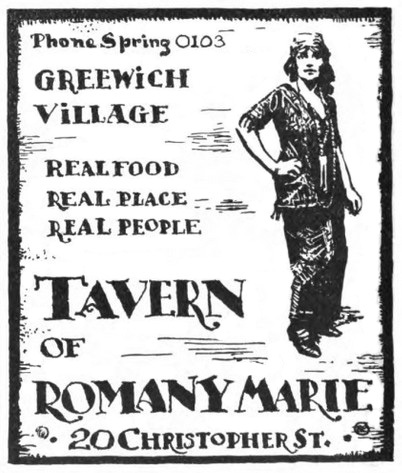
A bohemian version of a Romanian Restaurant was operated by Romany Marie in Greenwich Village. Sculptor Isamu Noguchi characterized it as “a sort of a transfer of the Paris café life to New York.” It’s likely this was true to some degree of many Romanian eating places which tended to exude a sense of good cheer and camaraderie all their own. [above: 1924 advertisement]

Many Romanian restaurants had prices in the reasonable range, with full dinners running from $1.00 to $1.25, but that was far from the case for the elegant restaurant in the Romanian House at the 1939 NY World’s Fair [shown above]. There the menu was in French, fresh caviar was $2.50, and a dinner was priced at $3.50, minus wine.
Outside of New York – in the late 19th and early 20th centuries before many Romanians dispersed into the larger population – there were Romanian colonies in other cities, both in the East and in the upper Midwest. Some were composed of Romanian Jews, but others, perhaps most, were communities whose members belonged to Catholic and Orthodox religions. Immigration to the U.S., almost nil from 1920 until the 1940s, resumed after World War II when the Soviets took over and continued through the 20th century and into the present.

It becomes harder to track Romanian restaurants in the later 20th century since they became less inclined to use Romanian as part of their names. But they certainly existed in Trenton, Chicago, Detroit, Cleveland, Miami, Los Angeles, and many other cities. One reason they might not have been clearly identified as Romanian was expressed in 1990 by Felicia Zanescu, proprietor of Mignon European Restaurant in Los Angeles. When asked why she called it European rather than Romanian, she replied, “Who ever heard of Romania?” Nonetheless the menu was convincingly Romanian with its carp roe dip, eggplant paté, dill-accented white bean broth, fried cheese, sausages, cabbage rolls, etc.
© Jan Whitaker, 2021
* Before 1975 Romania was usually spelled Roumania or Rumania.
September 5, 2021
Nan’s Kitchens

In 1919 two women opened a small tea room in Boston with just four tables. It was something of a lark. They had virtually no money to outfit it so they bought used furnishings. The location was a candlelit basement on Oxford Terrace in Boston, a romantic name for what would generally be known as an alley.
Anyone reading about their opening might have predicted they would fail spectacularly – especially after noting their rather boastful claims: “Such a place as we are about to open to the public is rare in New England. We are just trying out an idea and are seeking an answer to it by actual experiment rather than to obtain profits. If this is a success we will open others in large cities of the country.”
Despite being in an unpretentious building in a lowly area it turned out to be a very favorable location, in walking distance of the central Boston Public Library and Copley Square with all its hotels and nearby shops.

They named it Nan’s Kitchen after Nan Gurney, one of the founders. The two had met while in the Navy during World War I. Before that Nan had been married, but left her husband behind to join the service. Claiming desertion, he divorced her. Nan’s partner Thellma McClellan had worked as an astrologer before joining the Navy. Both enjoyed performing and were involved with vaudeville and amateur theatrics.
Nan’s Kitchen was an instant success, popular with members of the Professional Women’s Club to which they belonged. It also attracted fellow vaudeville performers. Publicity helped, particularly newspaper stories that made the tea room sound like a haven for romantic trysts at lunch and afternoon tea. They added more tables, but continued to specialize in one dish, chicken and waffles.
They must not have made much in the way of profits initially because they continued their side jobs as freelance teachers of music and elocution for several years. They were generous with the servers (who wore smocks, Oriental pantaloons, and artists’ caps), giving them a share of profits and paying them over the summer when the tea room closed.

In 1925 the pair seemed to become more serious about the restaurant business, opening a second tea room called Nan’s Kitchen Too at 3 Boylston Place. The next year the original Nan’s remained open all summer for the first time. The following year it was remodeled to resemble an outdoor garden containing a small cabin where a Black woman prepared the waffles, an arrangement also in use at the Boylston Place Nan’s. (Shades of Georgia’s Aunt Fanny’s Cabin? I would hope that Nan’s Black cooks were not costumed as Mammys!)

Although Nan and Thellma lived together in the 1920s, in 1930 they no longer did. In 1931 Nan went to New York where she worked as steward in an “exclusive Manhattan club,” according to an advertisement for Birds-Eye frozen foods. From 1934 to 1936 she ran Nan Gurney’s Inn, in her home town of Patchogue, Long Island, where she had grown up as Lettie L. Smith. After that, in 1937, she opened Nan Gurney’s Restaurant on Northern Blvd. in Flushing NY, specializing in “Long Island food.” [Flushing restaurant shown below later when it was Villa Bianca]

In 1932 Thellma, who had managed Nan’s Kitchen Too, was living in Connecticut. A version of Nan’s moved to the Motor Mart Building on Park Square and remained in business until 1935, but whether Thellma or Nan had any connection with it then is unknown.
© Jan Whitaker, 2021
August 22, 2021
Fish & chips & alligator steaks

The menu shown here caught my eye as I was browsing the internet. Of course, I wanted to know more about it. The first thing I discovered was that it is available as a reproduction.
Evidently the Trebor Dinner was a specialty menu for complete dinners of multiple courses. Three dollars was a steep price for the Depression when this menu was introduced, at least double what a comparable meal would have cost in a moderately-priced good restaurant then.
The illustrated menu shows 14 entrees. But the restaurant almost certainly did not have all the exotic items available at all times. Another fish & chips, inc. menu from 1937, for example, offered one appetizer, one soup, and only four entrees.
The menu could date any time from the opening of the restaurant in 1936 into the 1940s. Its clever design may have been due to owner Bob Winter’s background in advertising. Why the menu is named “Trebor Dinner” is a mystery. It’s possible that Trebor is a play on the owner’s name Robert.

Fish & chips, inc. was conveniently located in the Loop, across the street from the central Chicago library, now the Chicago Cultural Center. It was a handy location for a 1943 dinner of the literary members of the Boswell club, admirers of Doctor Samuel Johnson. In their honor the restaurant posted one of Johnson’s quotations over their table in which he criticized French menus, requesting “thy knaves to bring me a dish of hog’s pudding, a slice or two from the upper cut of a well roasted sirloin, and two apple dumplings.”

It was a popular restaurant, said to be especially well liked by male patrons. In 1944, during World War II, lines formed at the door. The following year it was enlarged to seat 300. [1949 advertisement shown]
With no meat on the menu, the restaurant would have had the advantage of escaping wartime food restrictions and shortages.
Advertising that it had 50 varieties of fish on hand daily, a lunch or dinner could include sunfish, crappies, smelts, cod, brook trout, sea bass, shrimp, and lobster among many others. The restaurant advertised heavily during the Lenten season.
Bob Winter died in 1953 and the entire contents of the restaurant were auctioned, including groceries.
© Jan Whitaker, 2021
August 8, 2021
Appetizer: words, concepts, contents
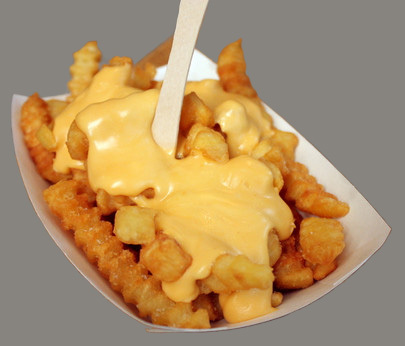
Appetizers became a prelude to a meal when many Americans suffered digestive problems in the 18th and 19th centuries. The idea was that appetizers were various items of fare that would help stimulate an appetite in those who were out of sorts. They could be foods, medicinal tonics, or alcoholic drinks.
Due to the strong influence of English customs in early America, the notion of taking something before a meal as a digestive stimulant more often than not meant an alcoholic drink rather than food. So the English term most often used – whets – referred primarily (though not exclusively) to drinks before dinner. The French equivalent of whets would be aperitifs.
As a term, however, “whets” did not appear on printed menus as far as I’ve discovered.
Drinks that usually served as whets/appetizers/aperitifs included rum, brandy, sherry, vermouth, champagne, and Dubonnet. In the 20th century especially, cocktails became a favorite pre-dinner drink.

While many diners began their restaurant meals with a cocktail, the drink itself was rarely referred to as an appetizer or whet after the 19th century. So I was quite surprised to find a Louisiana roadhouse restaurant listing Martinis, Old Fashion[ed]s, and Manhattans as appetizers in a 1956 advertisement!
As food, appetizers were usually lighter things consumed before the heavier Fish, Entrées, and Roasts courses typical of formal meals of the 19th century.

The word “Appetizer” itself though does not seem to have come into common use in American restaurants until the early 20th century. The term “Hors d’Oeuvres” was also used, as was “Relishes.” The French “Hors d’Oeuvre” tended to be used by higher-priced restaurants, such as New York’s Cafe Martin [1903], that sought to create an aura of continental elegance and sophistication.
Relishes initially referred to light vegetable foods, sometimes sauces. In the mid-19th century they were sometimes served just before the sweet courses, but by the early 20th century the category had risen to near the top of menus. Over time, the foods that had once appeared separately as Relishes tended to become included under the heading Appetizers.
But it’s almost impossible to firmly settle the question of what kinds of foods are found in the various categories – Relishes, Hors d’Oeuvres, Canapes, Appetizers, etc. The categories are loose and highly variable. One restaurant’s Relishes are another’s Hors d’Oeuvres.
A distinction is often made between Hors d’Oeuvres and Appetizers, stressing that the latter are eaten at the table in restaurants while Hors d’Oeuvres are one-bite morsels offered by servers to standing guests before they are seated. This distinction may hold for catered events but not for restaurants where there is no hesitation about using Hors d’Oeuvres as a general category.
Also confusing are the menus listing “Hors d’Oeuvres” as a selection under the headings Appetizers or Relishes. In 1917 a menu from San Francisco’s Portola Louvre actually put Hors d’Oeuvres under the heading Hors d’Oeuvres, along with caviar, sardines, celery, etc. Imagine a waiter asking, “Would you like some Hors d’Oeuvres for your Hors d’Oeuvres?
Until the 1960s and 1970s, the food items that were most commonly offered as beginnings to restaurant dinners were prepared simply and usually served cold. They have included: Fresh vegetables such as celery, radishes, artichoke hearts, and spring onions. Fresh fruits, including grapefruit and melons. Pickled and preserved vegetables, whether olives, beets, peppers, or traditional cucumber pickles. Preserved fruit combinations such as chutney and chow chow. Juices of tomato, grapefruit, pineapple, sauerkraut, and clams. Fresh seafoods — oysters, shrimp, lobster, scallops, and crab. And cured, smoked, pickled, deviled, and marinated meats and seafood/fish, including Westphalia ham, sausages, prosciutto, caviar, paté de foie gras, eels, herring, sardines, salmon, anchovies, and whitefish.
I am impressed that celery – en branche, hearts, a la Victor, a la Parisienne, Colorado, Kalamazoo, Pascal, Delta, stuffed, etc. – stayed on menus from the 19th century until long after World War II.

Heavier, more substantial, and often heated Appetizers seem to have been introduced post-WWII mainly by restaurants designated as Polynesian, Cantonese, and Mexican/Latin. In 1960 New York’s La Fonda del Sol offered appetizers such as Avocado Salad on Toasted Tortillas, Little Meat and Corn Pies, Grilled Peruvian Tidbits on Skewers, and Tamales filled with chicken, beef, or pork. A 1963 menu from a Polynesian restaurant called The Islander dedicated a whole page to its “Puu Puus (Appetizers)” that included ribs, chicken in parchment, won tons, and fried shrimp. The assortment was quite similar to the offerings at Jimmy Wong’s Cantonese restaurant in Chicago shown above.

By the 1980s, many restaurants featured appetizers that would now likely be called “Small Plates” or items for “grazing.” Two or three were substantial enough to make up a dinner in themselves, as demonstrated here by a rather expensive Spago menu from 1981.
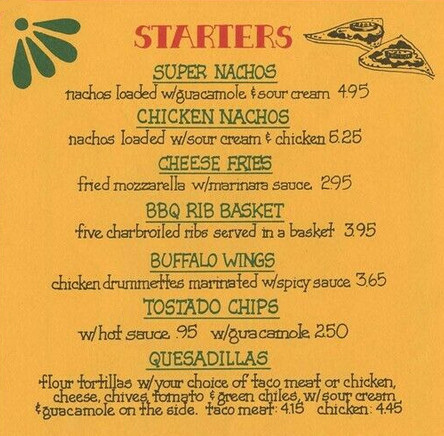
If grazing was a form of “light eating,” that could not be said of the appetizers introduced in the 1970s and 1980s by casual dinner house chains such as TGI Friday, Chili’s [1987 menu above], and Bennigan’s. Now the idea of an appetizer was completely turned on its head. Far from a light morsel that would induce appetite in someone with digestive issues, it became a digestive issue in its own right — deep fried and loaded with fat. The menus of leading casual dinner chains overflowed with “Starters” such as deep-fried breaded cheese, “loaded” potato skins, cheese fries [pictured at top of post], and heaping piles of nachos laced with pico de gallo and cheese. Diners might need a 19th-century digestive tonic after dinner.
© Jan Whitaker, 2021
July 25, 2021
French fried onion rings

It’s hard to say just how long french fried onion rings have been on restaurant menus. But it’s likely that they were served at the Grove Park Inn, in Asheville NC, shortly after it opened in 1913. A few years later politician William Jennings Bryan’s recipe for them appeared in a Boston newspaper in which he said that the inn was the first place he – a frequent traveler – had ever encountered them.
Women had been preparing them in their homes before that. A recipe appeared in Women’s Home Companion in 1905, but I’m sure they were known earlier.
Bryan’s recollection as well as the 1905 recipe settle the question of whether french fried onion rings were the 1920s invention of a Pig Stand in Texas as frequently claimed on the internet. They were not.

In the 1930s onion rings became more common in restaurants, probably aided by improvements in cooking oil (though many used lard) and deep fryers. Then, and for several decades later, they were usually featured as an accompaniment to a steak. In the heart of the Depression Schrafft’s advertized its Sizzling Steak Combination, saying, “With it you get generous helpings of French fried potatoes, onion rings or a fresh vegetable, a green salad, and a pot of Schrafft’s coffee, $1.50.” It ended with the tagline, “A Man’s Meal.”

They were often specifically marketed to men. Whether women shied away from them because of fear of breath contamination or some other stigma is unclear. Or maybe they enjoyed them just as much as men did, but were less likely to order steak because of price.
Despite the fact that men liked onion rings, onions in general carried a stigma. At various times in the last century they were characterized as “ordinary and even common,” as breath contaminators, and as food that restaurant kitchen workers did not like to handle. A 1966 handbook recommended that restaurant operators drawing up menus “shun” onions, along with lamb kidneys, pig’s knuckles, parsnips, turnips, and rutabagas. In 1969 a Gallup Poll found that potatoes were Americans’ favorite vegetables, followed by green beans, asparagus, corn, and tomatoes. French fried onions were ranked as slightly more popular than broccoli, lima beans, and peas.
Prejudices aside, onion rings grew more popular over time.

The arrival of pre-breaded frozen onion rings, which saved kitchen labor, was almost certainly part of their rising popularity. Their production began in the early 1950s when food companies contracted with fish processors who had learned the art of breading and freezing. Contra the Gallup poll, in 1969 one writer acknowledged that, after french fries, onion rings “must be the all time favorite accompaniment to hamburgers.”

Use of the ready-to-heat rings increased in the 1970s when fast food chains began to serve them. Some, such as those sold at Burger King, were made of ground onions that had been extruded through tubes in factories. Their uniform size and shape, suited for “portion control,” did not sit well with a restaurant reviewer in 1977. He complained that a Burger King in Seattle served onion rings that were “those pressed-onion jobs that come out all one size and lacking a great deal of onion taste.” What an ingrate! Didn’t he realize that extrusion meant he could count on always receiving the exact same number of grams of breading and ground onion as the next customer?
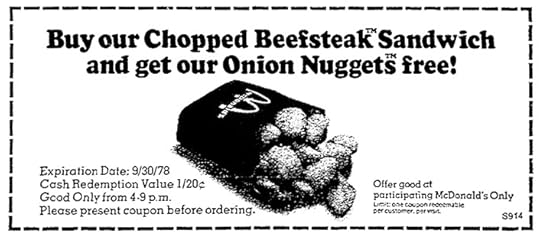
In 1978 McDonald’s began test-marketing their own version of deep fried onions, using chunks instead of rings and calling their “french fried chopped onion product” Onion Nuggets. But the nuggets didn’t make it past the test stage, reputedly because they got cold too quickly. Restaurant onion rings, in general, were often criticized for being served cold – as well as for being limp and greasy.
Overall, the historic trajectory of onion rings in restaurants seems to be:
Beginning in the early 20th century primarily as a garnish or accompaniment to a steakEspecially as onion prices rose, becoming a separately priced side order, often where hamburgers were popular such as drive-ins and fast food outlets.Ascending to the top of the menu — with inflated prices — as appetizers at dinner-house chains such as TGI Friday.Though not ring-shaped, Outback Steakhouse’s “Bloomin’ Onion” may have propelled deep fried onions to their historic pinnacle both in terms of fat and calorie load as well as price.
© Jan Whitaker, 2021
July 12, 2021
Hash house lingo
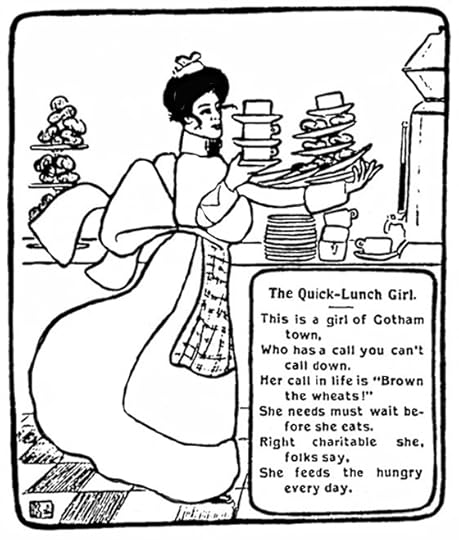
Odd – often humorous – names for simple restaurant orders were long associated with cheap eating places such as hash houses, beaneries, and lunch wagons. In addition to inexpensive food, patrons got free entertainment, while newspaper reporters never ran out of light copy.
In cheap restaurants it was customary through much of the 19th century and early in the 20th for servers to convey orders to the kitchen by shouting them out from the dining area. It’s highly likely that many, maybe most, of the servers as well as the cooks, were unable to read and write.
The colorful stories began to fill papers’ pages in the 1880s. In 1881 U.S. President Chester Arthur was reported to have visited a “coffee and cake saloon” in lower Manhattan – probably Hitchcock’s — where waiters shouted out his order of coffee and rare corned beef to the kitchen in slang.

Judging by how often it was repeated in the press, the public was endlessly amused by the tale of the clever Bowery hash house waiter who bested the patron who tried to confuse him by asking for two poached eggs on toast by adding that he wanted the yolks broken. Without a pause, the waiter shouted out “Adam and Eve on a raft. Wreck ‘em.”
Eggs merited the most jargon of all foods, probably because there are so many ways of preparing them. Two terms remain in almost universal use today and are so commonly used that probably no one suspects they were once regarded as unfamiliar waiter slang. I’m sure you will spot them easily in the list of egg orders.
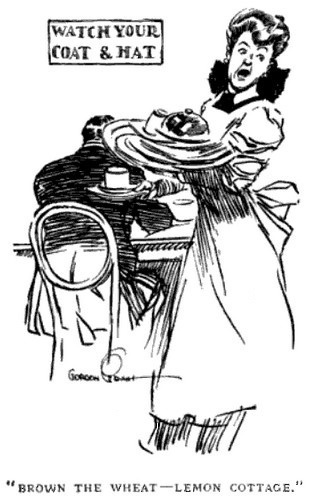
Many of these terms make no sense at all, and some have more than one reference. Why were they used? Clearly they are not necessarily shorter or easier to yell than if they were straightforward. According to the 1945 article Soda Fountain Lingo, “An exclusive language – racy, picturesque, humorous – understood only by the initiate, adds zest to the monotony. Further, it lends pride to the job and provides an esprit de corps. It gives incentive to the new waiter, mystifies the general public, and furnishes satisfaction to the enlightened professional hasher.”
Eggs
Ham and eggs – Kansas City chicken and Adam and Eve
Scrambled eggs — Adam and Eve shipwrecked; Agitated eggs; Storm tossed eggs; Eggs around the curve; Wreck Noah
Scrambled eggs with chili sauce – Ship wreck in the Red sea
Scrambled eggs on toast – Wreck on a raft
Fried eggs unturned — With eyes open; Sunny side up; Straight up; Two white wings turned down
Fried eggs turned over – In the dark; With a black eye; Over easy; Eyes closed
Fried eggs scalded in hot grease — Blindfold two
Poached eggs – Sleeve buttons
Poached eggs on toast – Two ladies on horseback; Adam and Eve on a raft
Soft boiled eggs – A light on the ocean wave; In the sea/ocean
Hard boiled eggs – A light under the waves; Two in the water like a brick
Meat/fish/main dishes
Dozen oysters stewed plain — Drown a dozen
Dozen oysters in the loaf — One in the coffin
Oyster stew – Two in a bowl; Stew-o-o-oo
Chicken stew — Springer in the mud
Corned beef hash – Brownstone front (can also refer to pancakes); Mystery
Wienerwurst and sauerkraut — A Dutchman’s paradise
Ham and beans – Ham an’
Beef and beans – Beef an’
Beans – Plate of Bostons; Thousand on a plate
Baked beans without the pork — Brass band without the leader
Beefsteak – Patent leather; One sole without a shoe
Mutton chops – Whiskers
Codfish ball – Sinker (also refers to doughnuts and to pancakes)
Spring chicken on toast and boiled potatoes — Foul tip and a hot grounder
Fried catfish (quickly) — Railroad a hot swimmer
Other
Macaroni — A son of Italy; Put up the flag
Buttered toast — Butter the gash
Pancakes — Brownstone front; Brown the wheats; String o’ flats; Stack ‘em up
Pancakes and coffee – Bootleg and sinkers
Buckwheat cakes – Brown the buck
Hot biscuit — Order of the boat heels
Doughnuts – Sinkers; Life preservers; Fried holes
Shredded wheat biscuits and a glass of milk – Couple o’ bales of hay & squeeze the cow
Milk toast – Cemetery stew
Chicken soup – Hen in the bowl
Slice of watermelon — The Red Man
Mince pie with powdered sugar on top — Indigestion in a snowstorm
Pie a la mode – Freeze out; Snow on the open face
No gravy – Make it dry
Keep it hot – In a hot box
Beverages
Hot tea — Cup of China; On the Chinaman
Tea without milk – Hong Kong on crutches
Iced tea — One in the mountains
Cup of coffee — One in the dark; Draw one
Glass of milk — One in the light; Squeeze the cow
Ice water – One Arctic
Customers often contributed to the lingo by inventing their own, both for ordering and asking someone to pass something.
Pass the sugar – Give the sand box a kick down this way
Request for butter – Pass the dope
Milk – Drive the cow down this way
Beans and molasses – Short and sweet
Fried pigs’ feet – A Trilby foot [Trilby was a popular 1894 novel about an artist’s model with beautiful feet]
Coffee and doughnuts – Slop and sinkers
Sandwich with a liberal allowance of ham – One boxing glove with plenty of lining
Hash house lingo died a slow death in the 20th century with the arrival of automated eating places, cafeterias, and other serve-yourself places, and was pretty much gone by the 1930s. It has been artificially revived here and there as a novelty attraction, the former Ed Debevics diners being a prime example.
© Jan Whitaker, 2021
June 27, 2021
The golden age of sandwiches

In their restaurant career sandwiches came from humble beginnings. They could sometimes be found in eating places as far back as the early 1800s, such as at the Ring of Bells, a porter and oyster house in New York. But they became more popular when they teamed up with beer joints after the Civil War. They also flourished in Boston’s “sandwich depots” of the 1880s — bean sandwiches included. And they were among the edibles offered by lunch wagons, saloons, and stand-up buffets in the late 19th century.
But it was the trend toward lighter mid-day meals in the early decades of the 20th century, spurred by the growth of cities, that gave sandwiches their big boost. Then, as light meals replaced hot dinners at noon, they found their niche, furnishing a quickly prepared menu item available in a variety of styles and combinations. Sandwiches of all kinds – named after celebrities, toasted, clubs, St. Paul’s — continued to flourish until after WWII when hamburgers began to take center stage.
While some eating places stuck with hot meals at noon in the early 20th century, others were quick to embrace sandwiches, particularly lunch rooms, tea rooms, drug stores, and delis. The sandwich shop was declared the winner among fast food restaurants. To critics the proliferation of this slapped-together fare was a sign of cultural decline. “The postwar decade might be known as the era of the sandwich,” declared cultural observer Eunice Fuller Barnard in a New York Times article of 1929 with the mournful headline, “We Eat Still, But No Longer Do We Dine.”

Among new developments was the formation of sandwich chains such as the Tasty Toasty and the Hasty Tasty. The B/G System was one of many in that category, which also included R&C, C&L, S&S, and no doubt other alphabetical combos across the USA. In 1924, the “Purely American, Meal in a Minute, No Tipping” B/G chain claimed to pay wages allowing their workers to “live according to American standards.” It had outlets in 16 large cities and was about to spread further. Was St. Louis the champion host of sandwich shops? Included among the city’s 52 sandwich shops in 1938, there were at least 6 “sandwich systems,” the Continental, Hollywood, Nickel Plate, Night Hawk, Ure-Way, and Yankee.


The sandwich selections on the menu shown here are from the Huyler’s confectionery-based chain. Tongue and Cream Cheese sandwiches, rarely (ever?) seen today, were quite popular in those early years (1921 menu above).


Polly’s Cheerio Tea Room’s Ham and Jam on French Toast would seem to be unusual, though perhaps Los Angelenos would have disagreed (1932 menu above).


I can’t account for why Schrafft’s in New York City felt the need to indicate which sandwiches were made with mayonnaise (1938 menu above). I’ve found one other tea room, located in St. Joseph MO, that included the same annotations.
Among the other interesting sandwich combinations I’ve found are Cucumber & Radish (25c at The Cortile in NYC in 1928); Egg and Green Pepper with Mayonnaise on Whole Wheat Gluten Bread (25c at Schrafft’s in 1929); “Chef’s Pride,” Smoked Tongue, Sliced Chicken, and Deviled Eggs double decker (50c at Townsends, San Francisco in1933); Peanut Salad (10c at The Candy Box in Winona MN in 1935); Peanut Butter, Sliced Tomato, Bacon, and Lettuce triple decker on toast (25c at The Little White House in NYC in 1936); and Marshmallow and Peanut Butter (15c at The Bookshop Tearoom in Springfield MA in 1946).
I prefer my BLTs without peanut butter. Hold the marshmallows, please.
© Jan Whitaker, 2021
June 13, 2021
Black Tulsa’s restaurants

(This post is a footnote to Robin Caldwell’s fine essay on Black grocers in the Greenwood community – my attempt to give some sense of the community by sketching a little about the area’s many restaurants.)
Before the Greenwood district’s destruction in 1921 – evaluated at $536M in property damage in today’s dollars — the area had become home to a prosperous Black business district filled with brick buildings, many of them housing eating places. Its leading citizens had done very well and a Black newspaper, the Tulsa Star, had begun publishing in 1913, with its office located near the heart of the business district at N. Greenwood and E. Archer avenues.

Nonetheless, like all of Tulsa, the area had its share of problems, no doubt due in large part to its rapid growth and the city’s attractiveness to transients and people on the make in both a good and a bad sense. Though generally striking a positive note, The Star complained of inadequate city services reflected in a failure of police to shut down gambling, prostitution, and bootlegging, and the lack of sewers in some parts of the community. Shortly before the massacre area residents petitioned the city, urging annexation of that part of the Black community outside the city limits and lacking modern improvements such as water, street lights, railroad crossings, fire stations, sidewalks, and paved streets. [Shown above: ca. 1915 photo of flooding in the 300 block of N. Frankfort street; Russell & Co. was a black-owned business.]
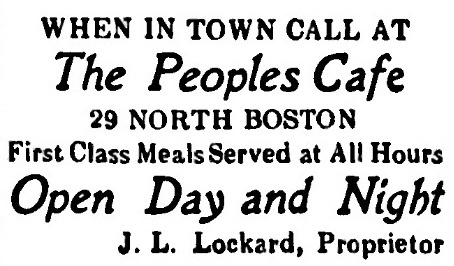
One of the most successful Black restaurant proprietors was Texas-born Joe Lockard who moved to Tulsa from his farm in Muskogee Indian Territory (Oklahoma). In 1914 he opened The People’s Café near Tulsa’s Frisco train depot. In 1920 he became president of the board of directors of a newly created investment company. That same year a white customer got into an argument with Lockard’s cook, shooting and killing the cook in the cafe’s dining room. Lockard’s café was destroyed by white rioters in 1921, but he continued in the café business into the 1930s, possibly later.
In contrast to Lockard, another Texan, Al Floyd, operator of the Cosy Corner [shown at top, 1915 advertisement from The Tulsa Star], was in business for at most a few years before relocating to Oklahoma City where he managed a railroad café.

The Busy Bee Café was run by Texas-born Savannah Elliott, also known as ‘Mother Elliott” despite only being in her 30s. In 1918 the newspaper mentioned that she entertained groups, such as teachers, and birthday dinners with as many as 17 guests. She sold the 112 N. Greenwood location at the end of that year, and moved to a new place that she operated briefly before again moving to Kansas City MO. In KC she and her husband ran a café called the Blue Goose. [1917 advertisement]

L. W. Wells ran a café in Okmulgee OK in 1914. The following year he moved to Tulsa, working in a white-owned restaurant called the Ever Eat Café. By 1918 he was running two quick-lunch cafes of his own in the Greenwood area where he provided “classy lunches” according to advertisements. It was wartime and business was booming, possibly because soldiers were passing through on the railroad. As the above advertisement indicates he was unable to keep his second location open because of the business crunch which probably meant increased patronage and a simultaneous shortage of help. In 1918 he had a dangerous brush with a drunken customer, engaging in a fist fight with him and pulling a gun. Like Lockard, he owned a farm in Oklahoma and was considered well off. The Star paper noted that for Christmas 1918 he presented his wife and daughter with a piano costing $475. His restaurant on Greenwood Avenue was destroyed in the 1921 attacks. [1918 advertisement]
Most of the cafes in the Greenwood district were basic, pricing meals reasonably, often charging 25 cents for a plated hot dinner. Many were open day and night. Their advertising stressed cleanliness. Most went by their owners’ names but there were also plenty of colorful names such as Busy Bee, Cosy Corner, Crystal, Ideal, Liberty, Little Pullman, Lone Star, Minute, Olympia, Palace, People’s, Red Rose, Square Deal, Star, and Sunny Side. (Because Tulsa was a Jim Crow city, it’s easy to identify which were Black restaurants – they were marked (c) in the city’s business directories.)
The greatest number of restaurants over the years 1913 through 1920 were on North Greenwood avenue. It intersected with East Archer to form the heart of the area’s business district, as well as bearing the brunt of destruction in 1921. East Archer had the second largest number of restaurants. I counted about 30 on North Greenwood during the 8-year period and 15 on East Archer, with another couple dozen on other streets.

Overall, the cafes went through a great deal of turnover and geographical churn – as was common throughout the US. They changed hands or moved to new addresses with some frequency. For example, Susie Bell’s cafe suffered fire damage when the Waffle House next door caught on fire in 1920. Although she had already moved several times, she was not defeated. She went out scouting for a new location early the next morning, confident she would be back in business by evening. In all likelihood she had “regulars” who counted on her to provide their daily meals. Her cafe was destroyed in the massacre. [1913 advertisement]
I had hoped to get an idea of what foods restaurants served, but that turned out to be difficult. Many advertised “home cooking” but almost never mentioned specific dishes. Usually when applied to basic cafes, home cooking referred to plain meat-and-potatoes dinners of the sort preferred by people who relied on restaurants for most of their meals. It’s likely that a fair number of residents of the Greenwood area lived in rooming houses and residential hotels with no cooking facilities. According to the 1920 federal census, about a tenth of Tulsa’s Black population were lodgers.
Though advertising did not offer much idea of what was served in the cafés, two foods were mentioned fairly frequently: Barbecue and Chili. Aside from the Black population born in Oklahoma, the next largest percentage were transplants from Texas, so it isn’t at all surprising that these two foods would be staples. There was also frequent mention of confectionery, pies, and cakes.
The one and only menu I discovered was for a 1918 Christmas dinner, billed as home cooking, at the Sunny Side Café. An advertisement also referred to it as a “Conservation” dinner, reflecting wartime rationing. In addition to a “Christmas Oyster Loaf,” the dinner included: Baked Turkey with Roquefort Dressing; Baked Chicken with Corn Dressing; Roast Goose with Sage Dressing; Smothered Duck with Brown Gravy; Cream Potatoes; Cream Peas; Griddle Corn; Macaroni; Stuffed Tomatoes; Stewed Prunes; String Beans; Cream Cabbage; Cranberry Sauce; Cherry Cobbler and Whip Cream; and the following pies: Pumpkin, Potato Custard, Mince Meat, Lemon Custard, Apple, and Cocoanut Custard.
Despite the enormity of the disaster in which possibly more than 300 Black lives were lost and there was extensive property destruction, survivors went to work almost immediately. Cafes that had been turned into rubble were rebuilt and reopened, and new locations were found. The area rebounded.
© Jan Whitaker, 2021
May 30, 2021
They delivered

Many restaurants survived the past year’s shutdown by offering curbside pickup as well as delivery by outside services. Neither takeout nor delivery is a new idea. Both stretch back into at least the 18th century when French-influenced “restorators” in cities offered a range of ready-to-eat food to be picked up or delivered to homes.
Deliveries included soups – a specialty of restorators – oysters, and full meals. A typical newspaper notice would closely resemble that of J. B. LeRebour of Salem MA in 1800, offering “all the delicacies that the season and market can afford . . . dressed for the epicure . . . Families in town may be supplied with Dinners and Suppers at the shortest notice.”
Notices in 1815 and 1816 from the versatile New York restaurateur, pastry cook, and confectioner Mrs. Poppleton give an idea of the kind of food that epicurean families might order. They included: Almond Soup; Savory Patties; Lobster Puddings; Chicken, Eel, and Game Pies; Anchovey Toasts; Omelettes; Italian Sallads; and Cold and Ornamented Hams, Tongues, and Fowls; as well as Savory Cakes and Pies.
Mrs. Poppelton also provided ladies with party trays. Clearly the notion of restaurant-ing then was closely tied to that of catering.
With the decline and disappearance of the French-influenced restorators by the 1840s, it seems as though home delivery pretty much dried up for a while.
Toward the end of the 19th century, some women interested in reducing household drudgery began to dream of a future when cooked food would be delivered to homes. Writer and thinker Helen Starrett, author of After College – What?, predicted in 1889 that cooking would one day leave the home just as had soap and butter making. She believed that meal delivery would succeed as a business “because capital will find it profitable.”
It wasn’t always profitable, though. Perhaps Starrett was unaware of the startling collapse in 1884 of one of the earliest for-profit ventures, The New-York Catering Company. Despite a strong beginning, with $100,000 capital and floods of orders from families, it failed due to poor management and the disappearance of subscribers during summer when they left town for the countryside.

The fate of other early companies is mixed. In 1890 the Boston Catering Company delivered not only dinner but also lunch and breakfast. Founded by Thomas D. Cook, it was carried on by son Walter. It fared better than The 20th Century Food Co. of New Haven CT, which lasted little more than a year. Its menus offered a range of choices in 1900, such as Breaded Lamb Chops, Beef Stew and Dumplings, and Corned Beef Hash.

Despite failures aplenty, interest in home delivery of ready-to-eat meals did not disappear, and grew even stronger in the early 20th century propelled by the “servant shortage.” Co-operative projects, such as the Women’s Industrial and Educational Union in Boston and the Central Co-operative Kitchen in Minnesota’s Twin Cities tried to take up the slack. And a number of women around the country began to run small enterprises out of their home kitchens, hiring boys on bicycles to deliver within relatively short distances.
Profit-making restaurant-based food delivery grew stronger at the same time. Examples include the Laboratory Kitchen of Boston, which retained a strong flavor of the co-operative movement. But other restaurants were purely business. For them, delivery was encouraged by the number of people able to order via telephone. Two New York tea rooms, The Colonia and The Fernery, delivered to businessmen who called in orders from their offices.

It wasn’t long before Chinese restaurants were taking delivery orders by telephone. And in the 1930s, fried chicken became a popular restaurant specialty for delivery. An interesting development was the opening of the first unit of the fried chicken delivery chain Flying Chicken in Albuquerque in 1946. Like the Kentucky Fried Chicken chain established in 1952, it did not provide any dining facilities. It advertised with slogans such as “Prepare Dinner with One Finger – Use Your Phone, Not Your Stove.”

Through the 1950s and 1960s, the idea of home delivery remained strong, increasingly focused on relatively limited menus, such as pizza, barbecue, or chicken, rather than full dinners or choices of many entrees. Still, here and there someone would start up full-service meal delivery with more ambitious selections and higher prices. For example, the Casserole Kitchen in New York City, begun in 1951 by a continentally trained chef, offered about 10 entrees each day. A sample dinner was Green Turtle Soup, Ham Imperial, Brussels Sprouts, Salad, and Vienna Chocolate Cake.

It wasn’t influential – and certainly not typical – but it’s impossible not to mention a phenomenon of the 1960s, San Francisco’s Magnolia Thunderpussy. Named for its proprietor, it was an eating place in Haight-Ashbury whose x-rated menu featured suggestively-named ice cream desserts and basic grub like stew (Mouthpiece Menage), and chili. Deliveries continued until 4 a.m., often handled by Magnolia herself.
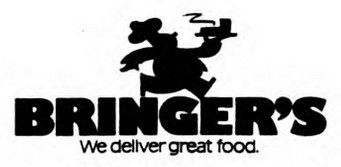
Today’s “ghost kitchen” concept – restaurant-less kitchens used only to prepare food for delivery — obviously isn’t new at all, going back to businesses such as the New York Catering Company of the 1880s. The arrangement remained strong in the 1950s and 1960s, even continuing into the 1980s. Examples include Phone-A-Feast (Peoria IL); The Orbit (Jersey City NJ); Mr. Dinner (Columbus OH); and Bring Me My Dinner (Stamford CT). General Mills, however, did not succeed with its trials of the concept: Order Inn was shut down in 1988 after one year, while the next experiment, Bringers, ended in 1992 after a two-year trial in Minneapolis.

Another delivery concept — such as Uber Eats or Grubhub that bring orders from any number of restaurants — isn’t new either. Messenger services, such as the Boys With the Red Sweaters (Bakersfield CA, 1910), provided early meal delivery for Chinese restaurants. In the early 1990s Las Vegans were served by Entrees on Trays, which handled deliveries from 20 restaurants.
Apart from pizza and Chinese food, it’s my sense that there were fewer restaurants and kitchens that delivered food to homes (and offices) in the 1980s and 1990s, perhaps because that was a time when going out to eat, often for entertainment as well as nourishment, became very popular with a wide swath of the population.
© Jan Whitaker, 2021
May 16, 2021
America’s finest restaurant, revisited

In the 19th century and well into the 20th there was absolutely no doubt that Delmonico’s was the nation’s finest restaurant, for decades the only one with a worldwide reputation. It was one of the few places in this country that European visitors compared favorably with the glittering restaurants of Paris’s “super mall” of the 19th century, the Palais Royal. [above: cafe section of Fifth Avenue and 26th Street Delmonico’s]

Founded by two Italian-Swiss immigrants in 1823 as a small confectionery shop in New York City, it soon grew into a “restaurant Français” occupying various New York City locations over its nearly 100-year run under family ownership. The Delmonico restaurants of the 1830s and subsequent decades were favored by foreign visitors, but soon Americans came to appreciate them too as their fame spread. As a form of homage — sometimes tongue-in-cheek — restaurants high and low, all over the USA, christened themselves Delmonico’s.
During much of the 19th century, most of America’s restaurants were located in hotels; up to the Civil War most operated on the American plan. This meant that everyone sat at large tables with others not necessarily of their choosing while bowls and platters of whatever was being served that day were set on the table to be shared – or not — by the diners. The Delmonicos introduced the European plan which allowed guests to have their own table and order just what they wanted, prepared the way they wanted.

An 1838 menu revealed that fine preparation was only part of Delmonico’s appeal. It also offered a profusion of dishes including 12 soups, 32 hors d’oeuvres, 28 entrées of beef, 46 of veal, 22 of game, 48 of fish, plus 51 vegetable or egg choices, and 45 pastries, cakes, and other desserts. (That 11-page menu is replicated in Lately Thomas’s classic book Delmonico’s, A Century of Splendor.) [Beaver street location shown above]
The number of dishes offered at Delmonico’s is overwhelming proof that the abbreviated reproduction menu that is commonly displayed and offered for sale online is a fake.
The original Delmonico brothers’ mission was what one observer writing in The Nation in 1881 characterized as establishing “a little oasis of civilization in the vast gastronomic waste which America at the time of their arrival presented.” For many Americans, the enjoyment of food bordered on sinfulness. Not only was it viewed as a monetary extravagance, claimed the essay, but there was a feeling among reform-minded people “that all time devoted to the table must be subtracted from that dedicated to spiritual improvement.”

So lauded was Delmonico’s that it’s necessary to point out that it had its critics who disliked the extravagant balls and banquets it hosted. In 1865, a year in which the newly Civil-War-rich were pouring into Delmonico’s, Morton Peto, a British railway and real estate developer, held a banquet for 100 guests. The cost was an astounding $250 a head. For comparison, as much as sixteen years later, the restaurant paid its waiters $30 a month. Another banquet that drew public disapproval was the dinner for James G. Blaine, a Presidential candidate in 1884. His backers, wealthy men who stood to gain from his election, were mocked in a front page cartoon in The World, which named the event after a Babylonian prince who tried to engineer his ascension to the throne. [above: front page of The World, 1884]
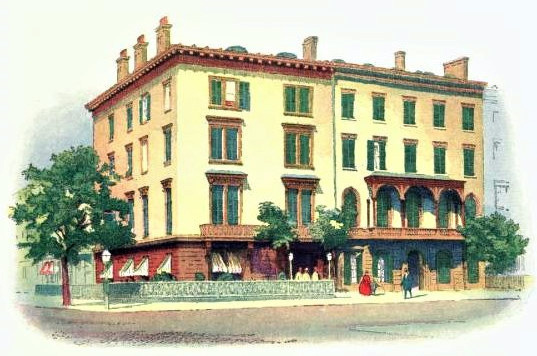
For a long time the Delmonico’s menu was entirely in French, without translation, a problem for English-only guests. If a guest ordered badly he (only men were given this task) imagined he could hear his waiter snickering. As a New York Times reporter put it in 1859, “we are made nervous by the sneerful smirk of the waiter, if we order the wrong wine in the wrong place . . .” And he might end up with a dinner of pickles and brandied peaches as happened to one hapless patron. The solution was to throw yourself on the mercy of the waiter and ask for his recommendations. [above: Fifth Avenue and 14th Street]

It’s interesting to note that Charles Delmonico, who ran the family empire following the death of Lorenzo, was said to be fond of the Italian restaurant Café Moretti. There he ordered risotto, a favorite dish that his restaurant’s French cooks did not know how to prepare. [above: Delmonico’s, Fifth Avenue and 26th Street]

Over time Delmonico’s moved from their initial “society” restaurant on the corner of Beaver, William, and South William streets [shown above, third from top] to three successive Fifth Avenue locations. Like all wise businesses, they were following in the path of their wealthy patrons. In 1862 they moved into an elegant mansion at Fifth Ave and 14th Street and in 1876 jumped up to 26th. In 1897 they settled in their final Fifth Avenue location at 44th Street, facing off with arch-rival Sherry’s. [above: Fifth Avenue and 44th Street]
Through the years the Delmonicos always kept at least one other location farther downtown for businessmen and politicians. The restaurant at 22 Broad Street served Stock Exchange brokers and speculators. It was said that for them “not to go to Delmonico’s for one’s lunch or tipple was to lose caste on ‘the Street.’”
In 1897 Delmonico’s yielded to music and smoking in its hallowed halls, a sign many regarded as evidence of a downhill slide. By then the 44th Street Delmonico’s was the last one doing business. It closed in 1923, a victim of weak management, increasingly informal dining customs, and Prohibition.
© Jan Whitaker, 2021
Delmonico’s was one of my early posts, and I realized I hadn’t given the subject its full due. This is an enhanced version.



